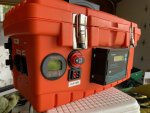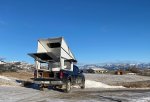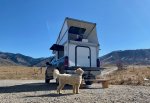Very Nice camper. What provisions have you made for ventilation? Do the alloy extrusions present themselves as a thermal bridge?
Thank you
@jwiereng and
@RDinNHand AZ for your encouragement and questions. It's easy to get stuck down the rabbit hole when chasing little design or production details, and I appreciate being able to step back and engage folks' ideas.
2020 has certainly been a wild year, but I'm grateful for the additional time that it has given me to put the prototype through its paces while working to kickstart manufacturing. I also feel fortunate to have been able to identify best-in-class suppliers whose expertise has facilitated a leap forward in material quality. Supply chains are still largely disrupted, leading to shortages and longer lead times in the near term, but the foundation is being laid for long term partnerships and scaleability.
Here are some highlights of the improvements from prototype to production model, informed by hands-on testing, manufacturer collaboration, and this community's ideas:
- Ventilation - Two operable windows will be included in base models, one larger in the back wall of the open wedge and one smaller in the camper's door or sidewall. Additional windows, fixed & operable, will be options that can be added during production or as DIY improvements thereafter.
- Composite panels - The prototype shell utilized 6mm aluminum composite sign panels set into the aluminum extrusions' grooves. The material is easy to work with and source, so it definitely deserves consideration in many DIY projects. However, a .01" aluminum skin and 6mm overall thickness may not provide the level of insulation or durability that many people desire in a camping rig. Following much research, discussion, and sample evaluation, I'm thrilled to be moving over to custom FRP honeycomb panels for the production units. These will provide more sound and thermal insulation, greater resistance to scratches/dings, and increased load capacity.
- Aluminum exoskeleton - The thicker FRP honeycomb panels on the production units will be inset from and bonded to the aluminum frame vs. the prototype's glazed-in 6mm panels. Whereas the prototype has all of its framing members exposed on the interior of the shell, the production units' frames will function more as an exoskeleton. This will limit the amount of exposed aluminum extrusions inside of the unit and greatly reduce thermal bridging.
- Skylights - The prototype's skylight has an incredible effect, flooding the camper with natural light and making the space feel bigger. A 6mm 3' wide clear acrylic panel was glazed into the roof's extrusions in between two aluminum composite panels to form the 9' long roof. The method and materials used pose challenges for long term weatherproofing when getting into the weeds of glazing, adhesives, and acrylic's thermal expansion. A 10' FRP honeycomb roof panel will be implemented on the production units, and a skylight(s) can be cut and bonded into the roof panel similar to fixed sunroofs on cars/trucks. The single piece FRP roof panel will allow flexible placement of the skylight(s) and optional roof fan with improved weatherproofing and insulation.
- Bed configurations - I have appreciated the flexibility of two movable bed panels in the prototype, as it provides various ways to configure the interior space. There's also much to be said for the convenience of a single lifting bed panel, and I plan to support this option for interested customers. A 2' opening at the rear of the camper can be achieved with either configuration for ease of access from the bed of the truck.
There are a myriad of other details under consideration and options being tested, so I'll work to keep y'all updated on developments. Please keep the ideas coming! I'd love to hear more about your interior systems and LiFePO4 power box,
@RDinNHand AZ. I've also been working on interior build-out options that I hope to offer as both DIY kits and plans. The prototype has been outfitted with modular benches, lights, a propex heater, 80W solar + batteries. I have applied a lot of the same principles used in the camper structure to the modular bench system, and it has proven to be a straightforward, high value upgrade to the base shell. I'll gather some photos and specs to share in a future post...
Now, I'd be remiss if I didn't throw some visuals into the mix. A photo is worth a thousand words, and y'all have endured plenty of mine if you've read this far:


 I removed the back wall to test some modifications on the door, and the prototype camper magically transformed into a moving van! Stay tuned for testing a fully operable back wall with inset camper door on the first production unit.
I removed the back wall to test some modifications on the door, and the prototype camper magically transformed into a moving van! Stay tuned for testing a fully operable back wall with inset camper door on the first production unit.
In the meantime, I've received my first batch of FRP honeycomb panels, so work on the flagship unit will soon be underway. 2020 has required a healthy dose of patience bringing a product to market and navigating supply chains, but I'm more excited than ever to forge ahead. The near term focus is finalizing design and production details while building the first production units. Recent developments with supplier and digital fabrication services are also a good step towards providing kit options down the road, so I am keeping the DIY folks in mind as things progress.
Thank you for your support and encouragement this year! 2021 is right around the corner, and I look forward to many more adventures, inspiration, and collaboration in the year to come.
Cheers!
Beau








